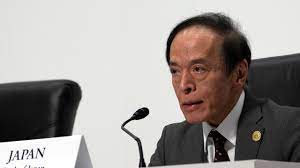Central Bank’s Momentous Move Signals Increasing Economic Vitality
TOKYO — For 17 long years, Japan embraced a bizarre economic paradox – charging banks interest for stashing cash rather than rewarding them. On Tuesday, this unprecedented era of negative borrowing costs came to an abrupt end in a tectonic policy shift by the Bank of Japan.
In a move few predicted would come so soon, the central bank raised its key short-term interest rate above zero for the first time since 2007. The decision definitively closed the book on an extraordinary period that began with negative rates being unthinkable before becoming reality in 2016.
The aim of this unorthodox policy, also deployed temporarily by some European economies, was to reinvigorate an economy plagued by stagnant growth and persistently low inflation. By effectively charging banks to park their excess reserves, policymakers sought to spur lending and incentivize spending over saving.
But after nearly two decades of treading water, Japan’s economy is finally showing increasing signs of life. As rising prices become ingrained in consumer expectations and companies grant heftier wage hikes, the need for such emergency monetary stimulus measures is waning.
“Based on our assessment that the virtuous cycle between rising wages and prices has taken hold, the Bank concluded that negative interest rates and other measures have fulfilled their intended role,” Governor Kazuo Ueda declared in explaining the quarter-point rate hike to between zero and 0.1%.
An Unconventional Experiment Ends
The decision marked a startling culmination of Japan’s long experiment with negative rates, a policy very much at the frontier of unconventional monetary policy. By becoming the first major economy to introduce sub-zero borrowing costs back in 2016, the Bank of Japan was entering uncharted territory in its fight against deflation.
At the time, the Japanese economy had spent much of the prior two decades mired in a deflationary quagmire. As prices and wages stagnated or declined, consumer spending withered and growth proved elusive despite endless monetary easing. Negative rates aimed to jump start lending and spending by taxing excess bank reserves.
While far from its original expectations, the shock policy did help power a modest recovery over time alongside other stimulus efforts. Still, it remained hugely controversial and fraught with risks like crippling bank profitability.
By 2022, most other major central banks like the Fed and ECB had exited negative rate territory as soaring inflation replaced disinflation as the key economic threat. But the Bank of Japan steadfastly clung to the policy as its homegrown issues with low inflation and growth persisted.
Not anymore. With inflation now firmly above 2% and wage growth accelerating rapidly, the rationale for maintaining crisis-mode policies has evaporated. In the parlance of central bankers, Japan has finally attained its “longed-for” virtuous cycle of price and pay hikes driving consumer demand.
“People no longer believe prices will just fall, so that mindset is now emboldening workers to push for bigger raises,” said veteran Japan economist Arnout van Rijn of Robeco. “This represents a fundamental shift in the dynamics underlying the economy.”
On the ground, 32-year-old office worker Shizuka Nakamura can attest to that shift playing out. “I definitely feel the rising cost of living weighing on my paycheck lately,” said the Yokohama resident. “Costs for essentials like baby diapers and formula have really jumped for myself and friends with young kids.”
1990s Bubble Memories Revived
The Bank of Japan’s abandonment of negative rates also carries heavy symbolic significance. It marks a pivotal break from an era of extraordinary policies aimed at escaping the deflationary trap that has plagued the economy since its 1990s asset bubble implosion.
For years, the central bank deployed ever-more unorthodox measures like negative rates and outright purchases of government bonds, stock funds and real estate trusts in hopes of catalyzing inflation and growth. It worked to directly suppress lending costs at all points along the yield curve via “yield curve control.”
Those measures were enacted at a time when Japan’s economic malaise seemed intractable – a so-called “lost decade” grinding on with no end in sight. But after 17 years of aggressive policy gambits, Japan is finally showing accumulating signs that it has turned a vital economic corner.
“This is another milestone for Japan in the long process of normalizing monetary policy after decades of trying to defeat persistent deflation,” said Van Rijn. “Long-term investors have been awaiting this signal that the economy has regained its footing.”
Indeed, domestic and foreign funds have piled into Japanese stocks lately in a remarkable rally. The benchmark Nikkei 225 index hit a new three-decade high on the day of the rate announcement, climbing 0.7% as investors celebrated the policy pivot as further confirmation of rosier growth prospects.
A Cautious Approach to Policy Normalization
Despite abandoning negative rates, the Bank of Japan took pains to reassure markets that it would proceed gradually in normalizing policy from here. Governor Ueda stressed that future rate increases, if any, “would rise at just a slow pace” as the central bank remains wary of snuffing out the nascent economic renaissance.
“Even after ending the negative rate policy, our stance will remain accommodative overall as we carefully monitor incoming economic data,” the governor told reporters. His dovish tone sparked some selling of the yen versus other major currencies as traders pared bets on aggressive further tightening.
After scrapping yield curve controls as well, the Bank of Japan has clearly embarked on an extended process of policy normalization. But the slower approach distinguishes Japan from the more abrupt credit tightening cycles pursued by the US Federal Reserve and European Central Bank over the past year.
For those institutions, rapidly accelerating consumer price pressures prompted unusually large interest rate hikes to prevent incipient inflationary psychology from taking root. Japan finds itself in the opposite situation – trying to foster and entrench inflation expectations after decades of pernicious disinflationary forces.
So while negative rates have been shelved, yield curve controls discarded and interest rates lifted off the floor, Japan’s central bank retains ample bandwidth to keep policy highly accommodative for some time to come. Short-term borrowing costs remain near zero compared to the fed funds rate above 5%.
“This first baby step higher in rates certainly isn’t the start of any aggressive cycle of policy tightening,” said Takeshi Niitsuma, market analyst at Tokai Tokyo Research. “The Bank of Japan seems set to move at a glacial pace from here as it assesses whether the new wage-price dynamics can be sustained.”
Still, the symbolism of jettisoning negative rates should not be understated. After being among the last major central banks to abandon the controversial policy experiment, Japan is signaling that its economy has achieved a profound turnaround in the dynamics that have weighed it down for so long.
For Japanese households and businesses, the end of negative rates means an era of extremely cheap credit has drawn to a close. Major commercial banks quickly announced they would begin paying interest, however meager, on customer deposits.
But the policy shift also carries optimism that years of economic stagnation and grinding deflation may finally be giving way to a period of healthier growth and inflation expectations – even if the road to full policy normalization remains long.
“This first increase in borrowing costs is still small in the grand scheme,” acknowledged Nakamura. “But honestly, with prices rising everywhere, it’s refreshing to feel like the economy has turned a real corner instead of staying stuck in the mud like it has my whole adult life.”






















